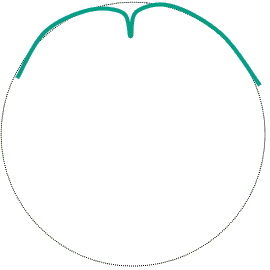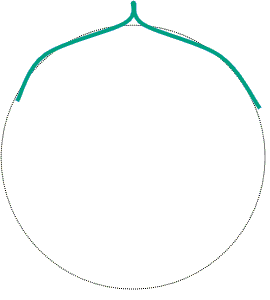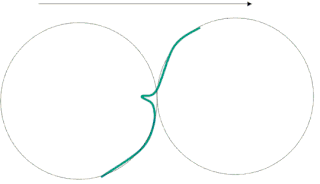
Figure skating is a sport in which individuals, pairs, or groups perform on figure skates on ice. It was the first winter sport to be included in the Olympic Games, when contested at the 1908 Olympics in London. The Olympic disciplines are men's singles, women's singles, pair skating, and ice dance; the four individual disciplines are also combined into a team event, first included in the Winter Olympics in 2014. The non-Olympic disciplines include synchronized skating, Theater on Ice, and four skating. From intermediate through senior-level competition, skaters generally perform two programs, which, depending on the discipline, may include spins, jumps, moves in the field, lifts, throw jumps, death spirals, and other elements or moves.
Spins are an element in figure skating in which the skater rotates, centered on a single point on the ice, while holding one or more body positions. They are performed by all disciplines of the sport, single skating, pair skating, and ice dance, and are a required element in most figure skating competitions. As The New York Times says, "While jumps look like sport, spins look more like art. While jumps provide the suspense, spins provide the scenery, but there is so much more to the scenery than most viewers have time or means to grasp". According to world champion and figure skating commentator Scott Hamilton, spins are often used "as breathing points or transitions to bigger things"
This is a list of dance terms that are not names of dances or types of dances. See List of dances and List of dance style categories for those.

In ballroom dancing, directions of progressive movement, in particular directions of steps, can be indicated either in relation to the room or in relation to the body position. Directions of turns, although there are only two of them, may also be indicated in several ways.
Because ballet became formalized in France, a significant part of ballet terminology is in the French language.
The toe loop jump is the simplest jump in the sport of figure skating. It was invented in the 1920s by American professional figure skater Bruce Mapes. The toe loop is accomplished with a forward approach on the inside edge of the blade; the skater then switches to a backward-facing position before their takeoff, which is accomplished from the skater's right back outside edge and left toepick. The jump is exited from the back outside edge of the same foot. It is often added to more difficult jumps during combinations, and is the most common second jump performed in combinations. It is also the most commonly attempted jump.
A spiral is an element in figure skating where the skater glides on one foot while raising the free leg above hip level. It is akin to the arabesque in ballet.

A 3 turn is a figure skating element which involves both a change in direction and a change in edge. For example, when a skater executes a forward outside 3 turn, the skater begins on a forward outside edge and finishes on a backwards inside edge. There are eight 3 turns in all: one for each possible combination of direction, skating foot, and edge.
A mohawk is a figure skating turn that involves a change of skating foot but not a change of edge. It is a turn from one foot to the other, from forward to backwards in which the entry and exit curves are continuous and of equal depth.

The chassé is a dance step used in many dances in many variations. All variations are triple-step patterns of gliding character in a "step-together-step" pattern. The word came from ballet terminology.
A twizzle is "a multirotational, one-foot turn that moves across the ice" in the sport of figure skating. First performed by David Grant in 1990. The International Skating Union (ISU) defines a twizzle as "a traveling turn on one foot with one or more rotations which is quickly rotated with a continuous (uninterrupted) action". It is most often performed in ice dance, although single skaters and pair skaters also perform the element. Twizzles have been called "the quads of ice dance" because like quadruple jumps in other disciplines, twizzles are risky and technically demanding.

A bracket turn is a kind of one-foot turn in figure skating.

A rocker turn is a kind of one-foot turn in figure skating. Unlike three turns and brackets, where the entry and exit edges follow the same curve, in a rocker, the entry and exit are on opposite curves. When executing a rocker, the skater turns inward on the curve of the entry edge, but exits on a curve in the opposite sense. Another way to look at it is that a rocker is similar to the entry of a three turn combined with the exit of a bracket. In a rocker turn, the skating edge is maintained; for example, a rocker from a forward outside edge ends on a backward outside edge.

A hydroblade is a figure skating edge move or connecting step in which a skater glides on a deep edge with the body stretched in a very low position, almost touching the ice. Several variations in position are possible, but one commonly performed by singles skaters is on a back inside edge with the knee of the skating leg deeply bent, the free leg crossed behind and extended outside the circle, and the upper body leaning into the circle with two, one, or no hands skimming the ice.
The following is a glossary of figure skating terms, sorted alphabetically.
Crossovers are a basic stroking technique in figure skating for gaining impetus while skating along a curve or circle. They may be performed while skating either forwards or backwards.
British Ice Skating is the national governing body of ice skating within the United Kingdom. Formed in 1879, it is responsible for overseeing all disciplines of ice skating: figure skating ; synchronised skating; and speed skating.
A step sequence is a required element in all four disciplines of figure skating, men's single skating, women's single skating, pair skating, and ice dance. Step sequences have been defined as "steps and turns in a pattern on the ice". Skaters earn the most points in step sequences by performing steps and movements with "flair and personality", by turning in both directions, by using one foot and then the other, and by including up and down movements. Step sequences in pair skating should be performed "together or close together". Step sequences must be a part of the short program, but they are not required in the free skating program. The step sequence must be "visible and identifiable", in any shape they like. The ISU defines a step sequence in ice dance as "a series of prescribed or un-prescribed steps, turns and movements in a Rhythm Dance or a Free Dance". Step sequences in ice dance have three divisions: types, groups, and styles.

Ice dance, a discipline of figure skating, has required elements that make up a well-balanced skating program and must be performed during competitions. They include: the dance lift, the dance spin, the step sequence, twizzles, and choreographic elements. The elements must be performed in specific ways, as described by published communications by the International Skating Union (ISU), unless otherwise specified. Choreographic elements are judged differently; they are considered complete if the minimum requirements defining the element are met.





